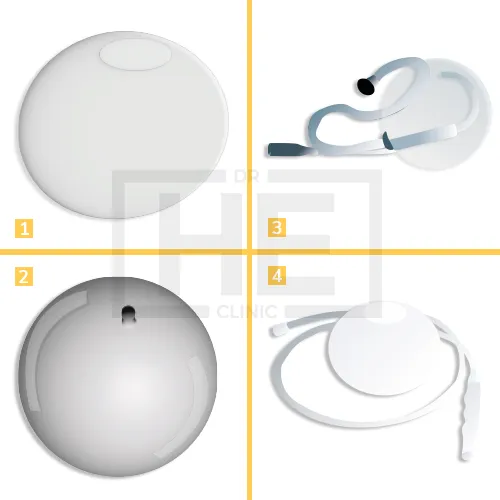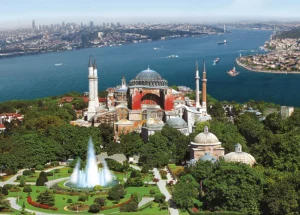Gastric Balloon in Turkey – Safe & Affordable in 2025
Gastric balloon treatment is a non-surgical weight loss procedure that involves placing a balloon in the stomach to reduce its capacity, helping patients feel full faster and eat less. Turkey is a popular destination for this procedure due to its affordable prices and high-quality medical services. The procedure is performed by experienced gastroenterologists in modern hospitals equipped with the latest technology. Patients benefit from comprehensive care, including pre-procedure consultations and post-procedure support.

Comprehensive Guide to Gastric Balloon in Turkey
Gastric balloon treatment in Turkey begins with an initial consultation and thorough medical evaluation to determine the patient’s suitability for the procedure. The process involves inserting a deflated balloon into the stomach through the mouth using an endoscopic method. Once in place, the balloon is filled with saline solution to occupy space in the stomach, helping the patient feel full sooner and eat less. The procedure is minimally invasive and typically completed within 20-30 minutes in a high-tech medical facility. After the procedure, patients receive comprehensive follow-up care, including nutritional guidance and support for lifestyle changes to maximize weight loss results.
Gastric Balloon Steps
1- Anesthesia: You’ll likely receive mild sedation or general anesthesia to ensure comfort and relaxation during the procedure.
2- Endoscope insertion: Your doctor will insert a thin, flexible tube called an endoscope through your mouth and down your esophagus into your stomach.
3- Balloon placement: The deflated balloon is attached to a catheter and carefully guided through the endoscope into your stomach.
4- Balloon inflation: Once positioned correctly, the balloon is inflated with sterile saline solution using a syringe attached to the catheter.
Catheter removal: The catheter is then carefully removed, leaving the filled balloon in your stomach.
5- X-ray confirmation: An X-ray might be taken to ensure the balloon is properly positioned and functioning correctly.
Types of Gastric Balloon

Orbera Balloon: Made of silicone material. Filled with sterile saline solution to a volume of 500-700ml. Remains in the stomach for 6 months. Known for its effectiveness and long placement duration.
Medsil Balloon: Composed of several small, swallowable balloons (3-4). Each balloon holds 250ml of gas (nitrous oxide or carbon dioxide). Placed endoscopically after deflating. Remains in the stomach for 6 months. Offers a less invasive placement method.
Spatz-3 Balloon: Made of silicone and features an adjustable filling mechanism. Filled with saline solution with a volume range of 150-550ml. Adjusted via a port connected to a catheter after placement. Remains in the stomach for 12 months.
Elipse (Allurion) Balloon: Made of a proprietary hydrogel material. Swallowed in a capsule form and expands naturally in the stomach with gastric fluids. Reaches a volume of 550ml. Remains in the stomach for 4 months.
Recovery After Gastric Balloon
First few days:
- Continue with the prescribed liquid diet and gradually introduce soft foods based on your tolerance.
- Pay attention to your body’s signals and rest when needed.
- Follow your doctor’s instructions regarding pain medication and other medications.
First few weeks:
- Transition to a regular, healthy diet, focusing on smaller, frequent meals.
- Drink plenty of water throughout the day to stay hydrated.
- Avoid sugary drinks, processed foods, and large portions.
- Start incorporating gentle physical activity as tolerated, gradually increasing intensity and duration.
Long-term
- Have regular appointments with your doctor to monitor your progress, adjust your diet and exercise plan if needed, and address any concerns.
- You may need to take vitamin and mineral supplements to ensure proper nutrient intake.
- Maintain healthy lifestyle habits like regular physical activity and mindful eating for sustained weight loss and overall health improvement.
Reasons for the Popularity of Gastric Balloon Turkey
Cost-Effective: Procedures in Turkey are generally more affordable compared to the US and Europe, making it an attractive option for international patients.
High-Quality Medical Services: Turkey boasts state-of-the-art medical facilities and highly qualified, experienced surgeons specializing in bariatric procedures.
Accredited Hospitals: Many hospitals and clinics in Turkey have international accreditations, ensuring high standards of care and safety.
Comprehensive Packages: Many Turkish clinics offer all-inclusive packages covering consultation, surgery, accommodation, transportation, and post-operative care.
Minimal Waiting Times: Unlike many Western countries, Turkey offers shorter waiting times for surgeries, enabling patients to schedule procedures more conveniently.
Tourism Opportunities: Patients often combine their medical trips with tourism, enjoying Turkey’s rich cultural heritage, historical sites, and beautiful landscapes.
Experienced Surgeons: Turkish surgeons are often trained in Europe or the US and are known for their expertise and high success rates in bariatric surgeries.
Positive Reviews and Testimonials: A large number of positive patient reviews and success stories contribute to Turkey’s reputation as a top destination for gastric balloon procedures.
Plan Your Trip to Turkey for a Gastric Balloon
| Timeline | Activity | Recommendations |
|---|---|---|
| 3-6 Months Before | Initial Consultation | Consult with your local doctor and a Turkish clinic remotely to discuss eligibility and potential dates. |
| 2-3 Months Before | Medical Preparation | Begin necessary dietary and medical preparations as advised by the surgical team. |
| 1 Month Before | Travel Arrangements | Book flights and accommodation. Arrange for medical visas if necessary. |
| 2 Weeks Before | Final Checks | Finalize all personal and medical preparations. Confirm travel itinerary and local transport in Turkey. |
| Arrival in Turkey | Pre-Op Consultation | Meet with your medical team in Turkey for a final pre-procedure consultation. Undergo any last-minute tests. |
| Day of Procedure | Procedure | Proceed with the gastric balloon procedure as scheduled. |
| 1-2 Days Post-Procedure | Recovery in Turkey | Stay in Turkey for initial recovery and follow-up appointments. Follow all post-procedure care guidelines. |
| Return Home | Post-Procedure Follow-up | Continue recovery at home with regular follow-ups remotely or with local healthcare providers. |
Tips for Ensuring a Successful Gastric Balloon Turkey
Research Thoroughly: Investigate clinics and surgeons in Turkey. Look for those with good reputations, international accreditations, and positive patient reviews.
Verify Credentials: Ensure the surgeon and medical team are certified and experienced in performing gastric balloon procedures.
Consultation: Have an in-depth consultation with your chosen surgeon. Discuss your medical history, expectations, and any concerns you may have.
Understand the Procedure: Gain a clear understanding of how the gastric balloon works, the procedure itself, potential risks, and expected outcomes.
Follow Pre-Op Instructions: Adhere to all pre-operative instructions given by your surgeon. This may include dietary restrictions and lifestyle changes.
Travel Arrangements: Plan your travel and accommodation in advance. Many clinics offer packages that include these arrangements, which can be more convenient.
Post-Op Care: Ensure you have a detailed post-operative care plan. This includes follow-up visits, dietary guidelines, and support from a dietitian or nutritionist.
Stay Hydrated: After the procedure, drink plenty of water to stay hydrated and support your recovery.
Diet and Exercise: Follow the prescribed diet and exercise regimen strictly. The success of the gastric balloon largely depends on your commitment to a healthy lifestyle.
Support System: Have a support system in place, whether it’s family, friends, or a support group, to help you stay motivated and on track.

Need Help? Contact Us!
7/24 Obesity Help Desk
Gastric Balloon
All Inclusive Packages-
Pre-Op Examinations
-
Sleeve Gastrectomy Weight-Loss Surgery
-
Medication and Diet Plan
-
6-7 Night Accommodation
-
Post-Op Support & Counselling
-
VIP Transportation
Gastric Balloon Turkey Cost 2025
The cost of a gastric balloon procedure in Turkey in 2025 varies, with prices generally ranging from approximately $1,600 to $2,600 USD.
The price can differ based on various factors such as the type of gastric balloon used (for example, the Spatz3 or Elipse Allurion brands), the clinic or hospital’s reputation, the surgeon’s experience, and the comprehensive nature of the service package, which may include pre- and post-operative care, accommodation, and transfers.
| Package | Price (USD) | Includes |
|---|---|---|
| Standard | $1,600 | Surgery, 3 nights hospital, hotel, transfers |
| Premium | $2,000 | + Dietician, extended aftercare |
| VIP | $2,600 | + 5-star hotel, translator, private nurse |
🌍 Gastric Balloon Prices by Country
Gastric balloon procedure prices vary significantly by country, with Turkey often offering some of the most competitive rates. The lower costs in Turkey are primarily due to the country’s favorable exchange rate, lower operating expenses, and government incentives to promote medical tourism. These factors allow Turkish clinics to provide high-quality care at a fraction of the price found in Western countries, making it an attractive option for international patients.
| Region | Average Gastric Balloon Cost |
 Turkey Turkey | $1,600 – $2,600 or more |
 USA USA | $7,000 – $12,000 or more |
 Canada Canada | $7,000 – $12,000 or more |
 UK UK | £6,000 – £8,000 or more |
 Australia Australia | AUD 7,000 – AUD 15,000 or more |
 Germany Germany | €6,000 – €10,000 or more |
 France France | €6,000 – €10,000 or more |
Why does Gastric Balloon Cost in Turkey Cheap?
- Economic Factors: The cost of living and operational costs in Turkey are generally lower than in many Western countries. This economic difference allows for lower prices for various services, including medical procedures.
Currency Exchange Rates: For many international patients, especially those from countries with stronger currencies, the exchange rate can make medical procedures in Turkey more affordable.
How to Reach Turkey?
By Air: Turkey is well-connected with direct flights from major cities around the world. There are international airports in Istanbul, Ankara, Antalya, and Izmir, among others. You can check for flights from your nearest major airport to one of these Turkish cities.
By Sea: Turkey has several ports that receive passenger ferries from neighboring countries and islands. You can travel to Turkey by ferry from Greece, Russia, Ukraine, and other nearby locations. Major ports include Istanbul, Izmir, and Antalya.
By Train: While not as common as air or sea travel, you can also reach Turkey by train from select European cities. The most common routes are from Sofia, Bulgaria, and Bucharest, Romania, to Istanbul. However, train travel to Turkey may require multiple transfers and take longer compared to air or sea travel.
| Departure City | Arrival City | Duration | Estimated Price |
|---|---|---|---|
| 🛫 London (LHR) | 🛬 Istanbul (IST) | ⏰ 3 hours 50 minutes | 💰 $300 |
| 🛫 Manchester (MAN) | 🛬 Istanbul (IST) | ⏰ 4 hours 35 minutes | 💰 $350 |
| 🛫 Paris (CDG) | 🛬 Istanbul (IST) | ⏰ 3 hours 25 minutes | 💰 $280 |
| 🛫 Frankfurt (FRA) | 🛬 Istanbul (IST) | ⏰ 2 hours 55 minutes | 💰 $320 |
| 🛫 Moscow (VKO) | 🛬 Istanbul (IST) | ⏰ 4 hours 25 minutes | 💰 $400 |
📸 Places to Visit in Turkey
Istanbul is a city where East meets West, blending centuries of history with a vibrant modern lifestyle. Start your journey at Hagia Sophia, a stunning architectural marvel that once served as a church and mosque. Right across, the Blue Mosque stands with its six minarets and elegant interior. Topkapi Palace offers a deep dive into the life of Ottoman sultans.
Don’t miss the Grand Bazaar, one of the world’s oldest and largest covered markets, and the nearby Spice Bazaar for colorful Turkish delights. For a unique view of the city, take a Bosphorus cruise and sail between two continents. Finish your day with a walk along Istiklal Street and a visit to Galata Tower for panoramic views.
As the capital of Türkiye, Ankara offers a different vibe from Istanbul—more laid-back, with a strong sense of national identity. The city’s highlight is Anıtkabir, the mausoleum of Mustafa Kemal Atatürk, founder of modern Türkiye. It’s a place of deep national pride and impressive architecture.
Visit the Museum of Anatolian Civilizations, which houses artifacts dating back to prehistoric times, showcasing the region’s rich cultural layers. Walk through Ankara Castle, offering sweeping views of the city and a peek into its ancient roots. The historic neighborhood of Hamamönü is perfect for a coffee break, with restored Ottoman houses, art shops, and local eateries.
Izmir, located on the Aegean coast, is known for its relaxed atmosphere, rich history, and youthful energy. Begin with a walk along the Kordon, a beautiful seaside promenade lined with palm trees and cozy cafés. Don’t miss the Clock Tower in Konak Square, the symbol of the city.
Explore the Agora of Smyrna, a Roman-era marketplace with columns and arches that whisper ancient stories. Dive into local culture at the Kemeraltı Bazaar, full of handcrafted goods and delicious street food. In the evenings, head to Alsancak for vibrant nightlife and sea-view restaurants.
Antalya is the jewel of the Turkish Riviera, known for its turquoise waters, golden beaches, and historical treasures. The old town, Kaleiçi, is full of charm with cobblestone streets, Ottoman-era houses, and boutique hotels. Discover Hadrian’s Gate, a Roman triumphal arch, and the ancient harbor now turned into a lively marina.
Enjoy a relaxing day at Konyaaltı or Lara Beach, perfect for swimming and sunbathing. Take a trip to the breathtaking Düden Waterfalls or hike in Köprülü Canyon. History lovers should visit the ancient cities of Perge, Aspendos, and Side, all within easy reach.





Gastric Balloon Before and After Photos
Submit your request for access to before and after photos to see actual patient results from our many cosmetic procedures and treatments at Dr. HE Clinic.
Gastric Balloon Turkey Reviews

Posted on
Truspilot
Posted on
TruspilotIs it Safe To Have A Gastric Balloon in Turkey?
- Lower Cost: Turkey offers significantly lower costs compared to many developed countries.
- Expertise: Many Turkish clinics boast experienced surgeons and modern facilities.
- Accessibility: Turkey is a popular medical tourism destination with convenient travel options.
Frequently Asked Questions About Gastric Balloon
Does Health Insurance Pay for the Gastric Balloon?
Health insurance coverage for gastric balloon surgery varies by plan and country. Often considered elective, this procedure may not be routinely covered, but coverage can depend on medical necessity and specific policy details. It’s best to check directly with your insurance provider for accurate information.
How Long Does Gastric Balloon Take?
Gastric balloon placement is a relatively quick procedure, typically taking about 20 to 30 minutes to complete. It is usually performed as an outpatient procedure, allowing patients to go home the same day.
Is Gastric Balloon Painful?
Do I Need to Stay in Turkey After Gastric Balloon Surgery?
Yes, you need to stay in Turkey for a few days after the Gastric Balloon procedure to ensure proper recovery, attend follow-up appointments, and manage any potential complications.
Which is the Best Clinic for Gastric Balloon in Turkey?
When it comes to finding the best clinic for a Gastric Balloon procedure in Turkey, DR.HE Clinic stands out as an excellent choice. Known for its state-of-the-art facilities and highly experienced medical team, DR.HE Clinic offers top-notch care and exceptional results. Patients benefit from personalized treatment plans, comprehensive pre- and post-operative support, and a commitment to ensuring the highest standards of safety and effectiveness. With numerous positive testimonials and a reputation for excellence in bariatric surgery, DR.HE Clinic is a leading destination for those seeking a successful Gastric Balloon procedure in Turkey.
QUALITY CERTIFICATES





















Posted on
Truspilot